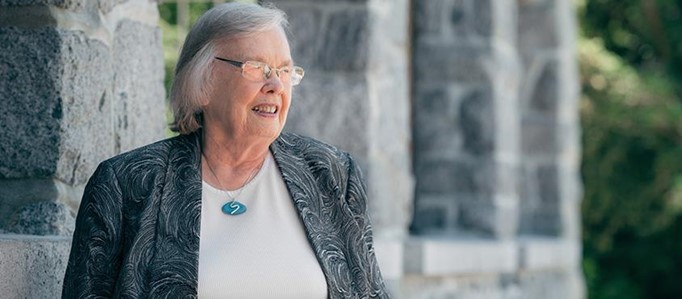
Charlotte Froese Fischer, a pioneer in the field of atomic structure calculations and an emerita research professor of computer science at Vanderbilt University, died Feb. 8, 2024. Fischer gained world recognition for the development and implementation of the Multi-Configurational Hartree-Fock approach to atomic-structure calculations and for her theoretical prediction concerning the existence of the negative calcium ion. For this last accomplishment, she was elected to grade of Fellow of the American Physical Society.
Understanding atomic structure provides a foundation for understanding chemical reactions, properties of elements, and the behavior of matter, which is key to fields like chemistry, materials science, and medicine. Dr. Fischer extended the Hartree-Fock method so it could be used to investigate even more complicated systems in which an atom’s electrons interacted with one another.
Devices such as lasers, atomic clocks, GPS systems and quantum computers all depend on the kinds of atomic structure calculations that Dr. Fischer specialized in. Her work had an impact on many different scientific fields, including spectroscopy, plasma physics, microelectronics and astrophysics, as well as biomedical and environmental sciences.
Dr. Fischer was at the top of her field at a time when there were very few women in physics or computer science. She obtained BA degrees in mathematics and chemistry and an MA degree in applied mathematics from the University of British Columbia in 1952 and 1954, respectively. She received her Ph.D. in applied mathematics and computing in 1957 from Cambridge University, where she pursued coursework in quantum theory with Nobel Laureate in physics Paul Dirac, a theoretical physicist who was one of the founders of quantum mechanics and quantum electrodynamics.
“Charlotte was indeed a pioneer. When I came to the School of Engineering, I was especially grateful for Charlotte’s presence given how few women were here then. In addition to being gracious and welcoming to me, she was a role model as an accomplished and well-respected woman in STEM. She was amazing,” said Cynthia B. Paschal, Senior Associate Dean for Undergraduate Education.
Fischer, 94, a Canadian-American scientist, was born in the Donetsk region of Ukraine. After spending some time in a refugee camp in Germany in 1929, she and her parents immigrated to Canada, eventually settling in British Columbia. She was the first in her family to attend university.
Dr. Fischer will be remembered particularly at the University of British Columbia, where she earned her first degrees and where she later taught in the mathematics department from 1957 to 1968. She introduced computer courses into the curriculum and helped establish the university’s computer science department. In 1963 she was the first woman to be awarded an Alfred P. Sloan Foundation Research Fellowship.
“When I joined Vanderbilt in 1994 as the William A. and Nancy F. McMinn Professor of Physics, I went around and visited with department chairs and other faculty in the sciences and engineering. My visit with Charlotte Fischer was particularly memorable – a gentle lady with profound career experiences that she gladly shared, while also being keen to get to know me,” Sokrates T. Pantelides, University Distinguished Professor of Physics and Engineering, Professor of Electrical Engineering, and Professor of Materials Science.
In 1967, she married mathematician Patrick C. Fischer, himself a noted computer scientist. As their careers advanced, Charlotte and Patrick Fischer took positions at the University of Waterloo, in Ontario, which was rapidly expanding its computer science program. Later they moved to Pennsylvania State University and eventually to Vanderbilt University, where she retired from the faculty in 1996. Dr. Fischer also worked for a time at the Harvard College Observatory in Cambridge, Massachusetts, and at Boeing, near Seattle.
“Charlotte was a great addition to the Vanderbilt faculty. She was an internationally recognized expert in computational atomic structural theory, and I always enjoyed my conversations with her,” said A.B. Learned Professor of Living State Physics John P. Wikswo, University Distinguished Professor of Biomedical Engineering, Molecular Physiology & Biophysics, and Physics. “She was not only dedicated to her work but also collegial and kind. I remember her smile while we talked about physics or Vanderbilt.”
For publishing more than 300 papers with more than 22 000 citations, Dr. Fischer is the highest-cited researcher on Google Scholar in the field of computational atomic physics. She also wrote two influential textbooks, and a scientific biography of her Ph.D. supervisor, physicist Douglas Hartree.
She was very active as a member of the international collaboration of Computation of Atomic Structure (CompAS) and the Atomic, Molecular, and Optical Science (AMOS) Gateway. Fischer received many honors, including fellowships in several professional societies and honorary doctorates from Malmö University in Sweden and Western University in Canada. she received a Fulbright Senior Research Award from the Benelux countries, and she was a Foreign Member of the Lithuanian Academy of Science.
Fischer was a generous supporter of several universities, STEM programs, and nature conservation. The Fischers established the Patrick and Charlotte Fischer Computer Science Scholarship in the Vanderbilt School of Engineering. The funds support undergraduate study in computer science.
Patrick Fischer, who died in 2011, taught for 18 years at Vanderbilt’s School of Engineering beginning in 1980 and served as chair of the computer science department for 15 of those years.
The Charlotte and Patrick Fischer are survived by their daughter Carolyn Fischer, an environmental economist and research manager at the World Bank.